The Microsoft Studio is powerful, but the Surface Dial is the real star
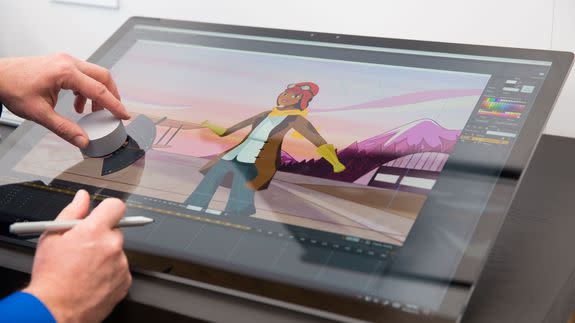
First, let's be clear: The Microsoft Surface Studio is not a "new category" of device, as company executives half-heartedly teased during the keynote leading up the big unveil. It is, fundamentally, an all-in-one PC. Microsoft has managed to give the device enough innovative features that it comes close to transcending the label, but it's still fundamentally a computer.
It also happens to be an incredibly practical one for a certain type of user. For creatives — illustrators, artists, draftspeople, et al. — the Surface Studio's killer feature is easily the chrome hinge that pushes the big 28-inch touchscreen down to a 20-degree angle. In that position, the Studio becomes an ideal digital workstation, with its touch and digital-pen inputs now front and center. It also puts the spotlight on the innovative Surface Dial accessory.
As intriguing as it is, the Surface Dial isn't a new category either. I remember using a Griffin PowerMate — a similar dial-like controller with customizable controls — with my Mac over a decade ago. However, Griffin didn't have the backing of a multibillion-dollar company, nor the versatility that Surface Dial has right out of the gate: I saw intricate custom Dial interfaces for at least a half-dozen professional apps at Microsoft's event Wednesday in New York.
SEE ALSO: Microsoft shows off its fun side with Windows 10 Creators Update
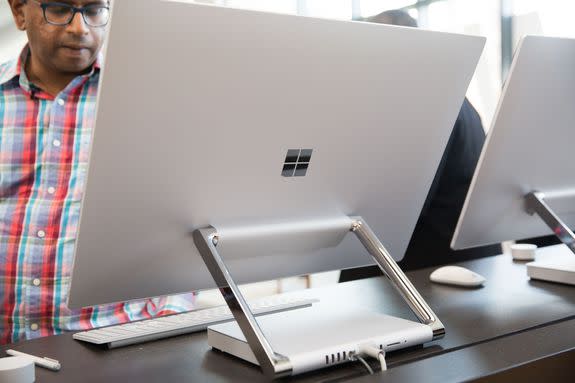
Image: LILI SAMS/MASHABLE
The Surface goes big
Although the Dial will work with both the Surface Pro tablets and Surface Book, it's really meant for the Surface Studio. Tellingly, its onscreen functionality — where a circular menu appears right beneath it — will only work with the Studio. When you pair it with a smaller Surface (it pairs to a single device via Bluetooth), the Dial still works, but you have to keep it on your desk, controlling the circle menus from afar.
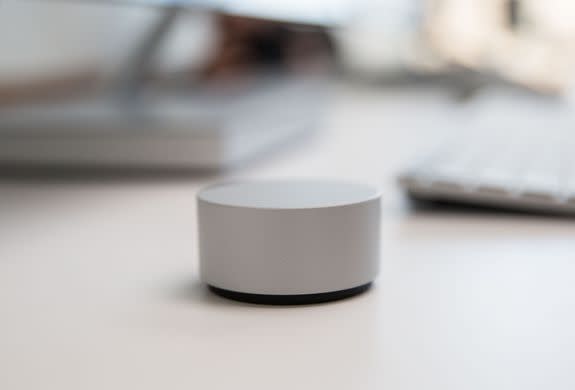
Image: LILI SAMS/MASHABLE
As an all-in-one PC, the Surface Studio is almost a contradiction, simultaneously gigantic — up close, you can really lose yourself in that screen — and minimalist. The profile of the monitor is just half an inch, and that's not just at the edge. You can almost hear it calling the iMac a muffintop.
The Apple comparison is clearly intended. Never has Microsoft been so brazenly Apple-like in its hardware, right down to the metallic texture of the magnesium chassis for the internals and the gray-and-off-white wireless keyboard. Not that it's a bad thing to rip off: The Surface Studio is gorgeous.

Image: LILI SAMS/MASHABLE
Adjusting the display really is as easy as Microsoft says: You can do it with one hand, although whether or not you can do so comfortably will depend on how often you work on your forearms at the gym. Importantly, you can't lock it at angles greater than 20 degrees, so it's definitely more drafting table than easel.

Image: LILI SAMS/MASHABLE
Performance-wise, it's a Windows 10 PC writ large. The 28-inch canvas means gestures become huge sweeping motions. The powerful Intel Core i7 chip and Nvidia graphics processor are exactly what pro-level users demand, and they're absolutely necessary on this machine. Even with all that power, I saw a highly detailed CAD drawing in an app from Siemens NX struggle to keep up with pinching and zooming. Still, the resolution stayed ultra-crisp throughout. You can't see pixels unless you get in really close.

Image: LILI SAMS/MASHABLE
My colleague Lance Ulanoff found drawing on the screen to be a real pleasure: "I liked being able to lean on it and get real close to my doodles, though I can feel the heat of the screen. That's a little unpleasant. Even so, this is such a responsive system and I bet any designer or artist who spends a little time with it will be smitten."
Dial me in
Using the Surface Dial, a $99 accessory, is more intuitive than it first appears. It works like this: You plop it on the screen, where a menu specific to your app appears. Dial to the function you want (say, volume), push in to select, and now the dial will make adjustments as you twist. For nested menus, you just keep pushing to select. Easy-peasy.

Image: LILI SAMS/MASHABLE
Without any product managers to guide us, Lance and I tried using the Dial in a drafting app called Drawboard to draw straight edges at precise angles. Using the Dial on the screen, we twisted it to select the Protractor tool, then turned to line up a ghost-like ruler to the angle we wanted to draw. Of course, drawing along the line produces a perfect straight edge. Use the tool again, draw to intersect your line and boom — you have the perfect angle.
Developers customize the Dial's functions to their specific apps. In a painting app, the Dial can adjust the color, shape or opacity of a paint stroke as you draw with the Surface Pen. Drawing in rainbows is obviously a parlor trick, but I could see artists using the tool for subtler changes in brush strokes. It's not something every artist will want, and those that do will probably use it sparingly, but for those that want it, I imagine it'll be invaluable.
Something that I can see being invaluable to all is split-screen zoom. Take a document like a blueprint or map, activate split-screen zoom, and now when you place the dial on the image, the other side of the screen zooms in on the details. You can rotate the dial to zoom in or out. Repeat for different parts of the image. I can see this being really useful for, say, architects, where you repeatedly have to scan details on plans and make notes or marks.
The whole idea behind the Surface Dial, Microsoft product managers told me, is to keep from interrupting the "flow" of creative work — to replace the act of going back into palettes or toolbars with more intuitive pushes and twists of the Dial. From my limited time with the device, I'd say they succeeded. I can really see people who, for example, work in CAD all day come to love this thing.
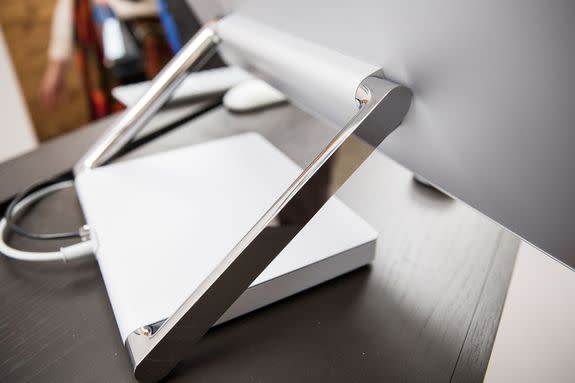
Image: LILI SAMS/MASHABLE
I could say the same thing for the Surface Studio, though in that case it's a backhanded compliment. The Studio is powerful, beautiful and practical for many, no question, but it's also limiting in some ways. Not being able to lock the display at angles greater than 20 degrees or turn the screen vertically feels like a missed opportunity to serve certain users — surprising given the superb hinge on the Surface Pro 3 and 4. And then there are the confounding details: Why are all the ports on the "brain" unit (including the SD card slot) rear-facing? Finally, the price is beyond luxury: $2,999 is just the low-end model; for the top of the line, you'll need to spend $4,199.
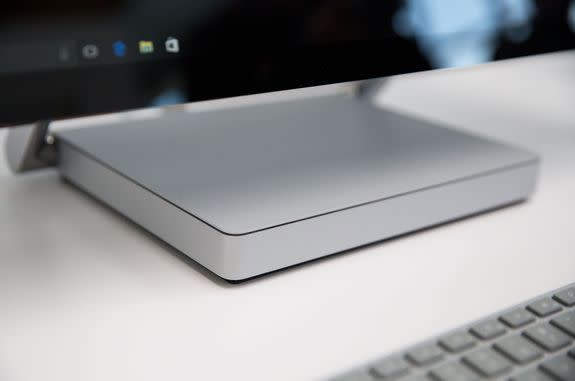
Image: LILI SAMS/MASHABLE
That said, new category or no, Microsoft has created something to be excited about here. While the Surface Studio is overkill for practically everyone, for an elite few, it delivers something they couldn't get before: all the power of a pro-level system paired with the creative tools — and a clever accessory — they need. And it's all in a impressively large Surface-branded device that's the size of a small table. Hm ... where have I heard that before?

 Yahoo News
Yahoo News 